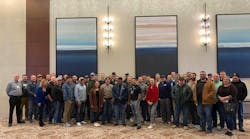When someone views something, anything, it is viewed through their perspective. Whatever “it” might be, it is perceived via the viewers own prejudices, opinions and general emotional state. The buzzword for such viewing, today, is “optics.” Whether it is a political opinion, personal interaction or even a motion picture or concert, the event is filtered by the viewer. The optics of a moment, photo, movie, speech or other incident do not appear the same to everyone. A good example of this phenomenon is the current pedantic concern in the political arena over what people perceive during a speech or photo opportunity as opposed to what actually occurred...what someone perceives is being said, versus what is actually said. What someone perceives is being done as opposed to what is actually being done. The news media will tell viewers who were not at the event the who, what, why and where, and they will do so through their own perceptions, prejudices and agenda. It’s all optics. What does something look like? It depends on who is telling the story or witnessing the event.
In the trades, optics are very important to your business and how it grows or doesn’t. We are all familiar with the apocryphal “plumbers crack.” The visual of a plumber bent over working, shirt raised a bit while his derriere, partial butt crack and all, is visible above his belt line, has become a common source of amusement whether or not someone has actually seen such a situation or not. That’s optics too.
It used to be that customers had the expectation of a plumber or HVAC tech who was knowledgeable, competent and skilled. How that person looked was, in most cases, not as important as what that service person knew and could do, as well as how respectful of the customers’ home or property he was. That criteria has now morphed into an optics moment. When George Brazil had the image of the tall, smiling, good looking, immaculately uniformed service man carrying a tool box painted on his trucks, the optics said it all. People, especially the lady of the house, were more likely to “call George” if they needed a plumber merely because of the impression, or optics, that the logotype imparted regardless of the actual serviceman who might show up. The was an expectation that the customer was going to get “George” walking up their driveway to fix that leak. This sort of subliminal advertising has proven to be very successful for many shops.
What do today’s customers want in a service contractor? They want exactly the same thing as customers’ did 50 years ago, but they want it in today’s technology.
I can give you a perfect, personal, example of how optics works. Many years ago, when I was a young journeyman, I was hired by a service shop. Coming from a commercial/industrial background, where competence and skill were the only panacea, and not having worked in the residential market very much, I was surprised by the differences in what was deemed important to the boss. Skill and competence were valued, of course, but optics were given pride of place. The shop required, and provided, uniforms for all employees. The typical name badge sewn over the right breast pocket and the shops name over the left was more than just advertising. While the overall performance of the individual journeyman might have been an unknown to the customer, the fact that we all presented a unified appearance when arriving at their home or place of business said a great deal...optics.
This shop went one step further. All the trucks, in addition to being painted exactly alike, were built out inside with cabinetry, shelves and racks. Each truck was identical to every other truck as to what material was stocked on board and where that material was. Even a truck that was kept on hand as a spare was laid out and stocked exactly the same as every other truck, in case of a breakdown where a plumber might have to switch vehicles at the last moment. Any plumber could go to any truck and know exactly where the half inch brass nipples were, or copper fitting or black steel fittings or whatever they were looking for. Again, optics at work. Every time a truck arrived at the customers’ home, it looked just like every other truck from the shop, right down to where the B-tanks were secured.
Consistently providing good service from uniformed personnel, arriving in identically painted and provisioned vehicles gave the customers the optics the shop owner wanted to impart. Adding in radio communications for dispatch, speedy conflict and material resolutions was the icing on the cake. Notwithstanding the level of craftsmanship he demanded of his employees, the shop’s owner was very aware of how he wanted his business perceived (optics) and it showed in the good reputation and repeat customers he enjoyed.
Fast forward to today. What do today’s customers want in a service contractor? They want exactly the same thing as customers’ did 50 years ago, but they want it in today’s technology. Customers in the information age want their service people to be technically savvy. To be sure, they want them to be competent in their trade, but they also want them to be up to date. What does that mean? It means using phone apps and iPads to acquire and utilize data on any particular matter. Billing, material pricing, availability, communications are only some of the things today’s customers require of their service people. It’s not only smart to be able to sell a customer that new kitchen sink or faucet or fixture by showing them on your laptop or iPad, it’s something they expect! The use of data technology and its integration into your interactions with customers is not an extra, it’s a requirement!
A recent survey of customers showed that the service companies that would receive their repeat business were the shops that utilized the most cutting edge technologies. Some said it was expected, but other said that it was a deal breaker if their preferred service technicians did not have laptops, iPads or smart phones with which to impart information, billing appointments or other data on the spot. This is optics in 2018.
Regardless of your skill set, trade knowledge and abilities, if you aren’t integrating current data technologies into your customer service routines and hitting them hard, your optics are falling behind. No longer is it all about the work. Now every single person that interacts with your customers needs to be able to do so using as much modern data technology as is appropriate for the call and selling every time they walk into that home or place of business or you are losing ground.
The Brooklyn, N.Y.-born author is a third-generation master plumber. He founded Sunflower Plumbing & Heating in Shirley, N.Y., in 1975 and A Professional Commercial Plumbing Inc. in Phoenix in 1980. He holds residential, commercial, industrial and solar plumbing licenses and is certified in welding, clean rooms, polypropylene gas fusion and medical gas piping. He can be reached at [email protected].









